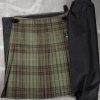The History of the Kilt: From Tradition to Modern Trends
The kilt is one of Scotland’s most iconic garments, steeped in history, culture, and national pride. Over the centuries, the kilt has evolved from a practical item of clothing to a fashion statement worn on special occasions. In this blog post, we’ll explore the rich history of the kilt, its changing trends, and the various occasions where it remains an essential part of Scottish attire.
The Origins of the Kilt
The kilt can trace its origins back to the 16th century when Highland clansmen wore the féileadh mòr or great kilt. This large piece of woolen fabric was draped over the body and secured with a belt, offering warmth and versatility in Scotland’s rugged landscapes. The fabric could also double as a cloak or blanket, making it a practical choice for the Highland way of life.
By the 18th century, the great kilt evolved into the féileadh beag (small kilt), resembling the modern kilt we recognize today. This version was pleated at the back and worn with a separate jacket, making it more practical for everyday wear. However, after the Jacobite Rebellion of 1745, the British government banned the wearing of kilts and tartans in an attempt to suppress Highland culture. This ban remained in place until 1782, after which the kilt experienced a resurgence in popularity.
Kilt Trends Through the Years
Over the centuries, the kilt has undergone several transformations, adapting to cultural and fashion trends while maintaining its distinct heritage:
- 19th Century: The kilt became a symbol of Scottish nationalism, often worn by military regiments and members of the aristocracy. Queen Victoria’s love for Scotland also contributed to the kilt’s rise in popularity among the upper class.
- 20th Century: Kilts became more widely worn at formal events, particularly at weddings, Highland Games, and official ceremonies. Different tartan patterns were designed to represent clans, families, and even organizations.
- 21st Century: Today, kilts are worn for both traditional and modern fashion purposes. While traditional tartans remain popular, contemporary designers have introduced kilts in new fabrics, colors, and styles, appealing to a broader audience beyond Scotland. Additionally, utility kilts—practical kilts made with additional pockets and rugged materials—have gained popularity among modern wearers.
How Kilts Are Made
The craftsmanship involved in making a kilt is both an art and a science. Traditional kilts are made from pure wool tartan fabric, typically requiring about eight yards of material. The pleats are carefully stitched to ensure they hold their shape, and each kilt is tailored to fit the wearer perfectly. Modern variations include synthetic fabrics, which provide added durability and affordability.
Occasions Where Kilts Are Worn
The kilt is a versatile garment, worn at a variety of events to celebrate Scottish heritage and culture. Some of the most common occasions where kilts are worn include:
- Weddings: Scottish grooms and groomsmen often wear kilts as part of their formal wedding attire, paired with a Prince Charlie jacket and sporran.
- Highland Games: Kilts are a staple at the Highland Games, worn by competitors and attendees alike as a symbol of Scottish tradition.
- Burns Night: Celebrated on January 25th, Burns Night honors the famous Scottish poet Robert Burns, and many attendees wear kilts for the occasion.
- Formal Events: Kilts are commonly worn at black-tie events, gala dinners, and ceilidhs, adding a touch of Scottish elegance to the occasion.
- Military and Ceremonial Use: Many Scottish regiments in the British Army still wear kilts as part of their dress uniform, maintaining a long-standing tradition.
- Casual Wear: While kilts are most often associated with formal events, modern variations make them suitable for everyday wear, particularly at festivals and cultural gatherings.
The Role of Tartan in Kilt Design
Tartan patterns are deeply significant in Scottish culture, often representing different clans or regions. Some tartans are restricted to specific families, while others are available for general wear. Today, many businesses, universities, and organizations design their own tartans, further expanding the relevance of the kilt in contemporary life.
The Kilt Today: A Blend of Tradition and Modernity
The kilt remains a strong symbol of Scottish heritage, embraced by Scots and enthusiasts worldwide. Whether worn in a traditional tartan pattern or reimagined in contemporary styles, the kilt continues to be a statement of pride, identity, and fashion. As trends evolve, one thing remains constant: the kilt’s enduring presence in Scottish culture.
From its origins as a practical Highland garment to its current status as an emblem of tradition and fashion, the kilt continues to captivate wearers and admirers alike. Whether you’re donning one for a wedding, festival, or everyday wear, the kilt remains a cherished and versatile piece of Scotland’s rich history.
Do you own a kilt, or are you planning to wear one for a special occasion? Let us know how you style yours in the comments below!





